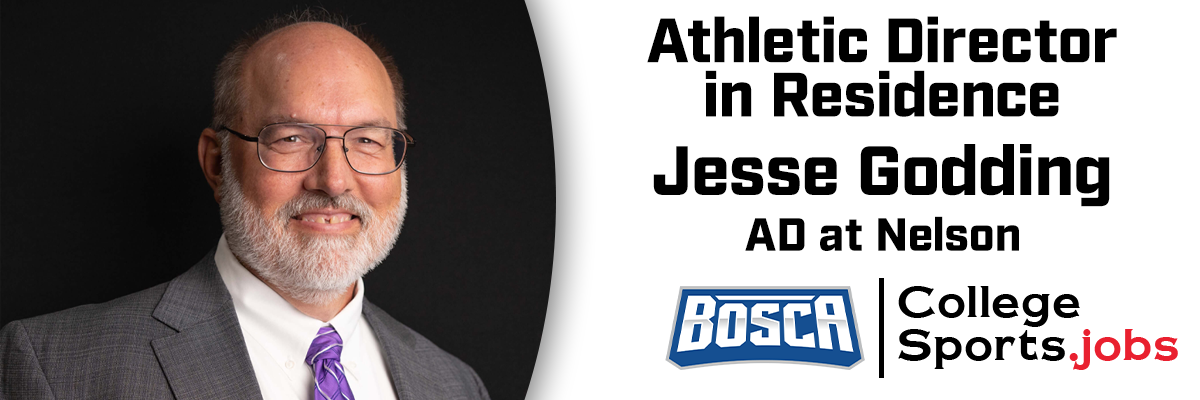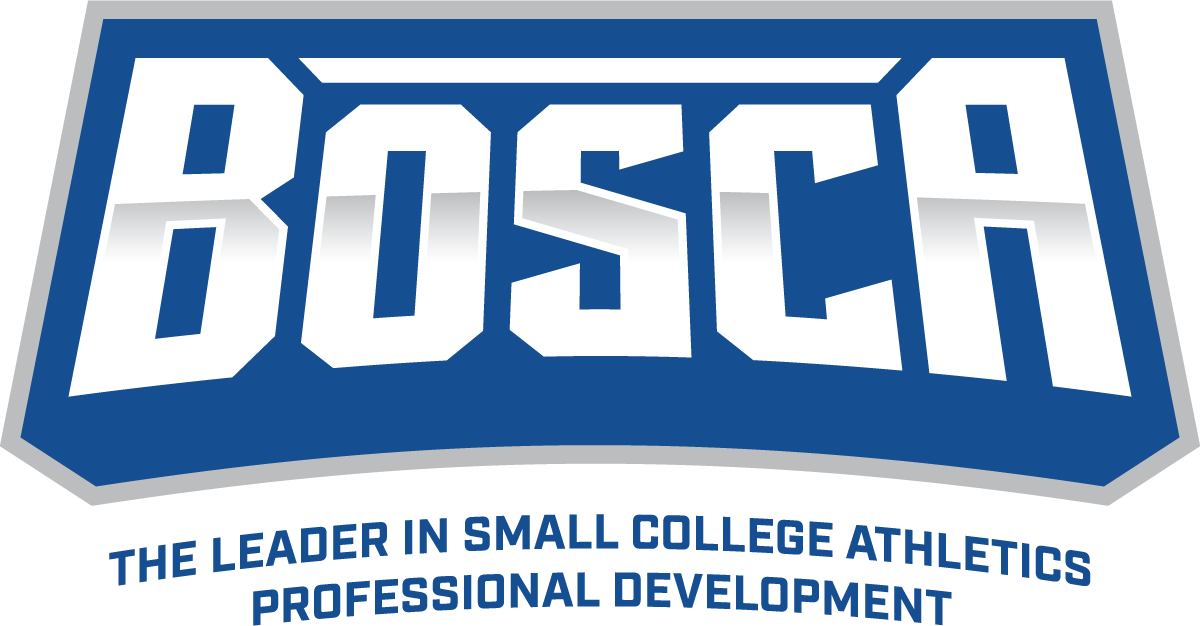AD in Residence: Nelson AD Jesse Godding
Nelson AD Jesse Godding on the impact of the university's rebrand, growth through athletics, facility projects, the future for the NAIA and more.

You’re in year 13 as an AD after serving as a head football coach. SAC Athletic Director of the Year three times to Godding (2014, 2021, 2022) and he was named a Cushman and Wakefield NACDA Athletic Director of the Year in 2023. What’ve been the biggest contributing factors in your ability to build momentum and maintain success in your athletics department?
I would begin by saying there is no overnight success in athletics, just fortunate individuals with the correct blend of experience, skill set, and setting in which to thrive.
Experientially, my upbringing, athletic involvement, and opportunities to be in under-resourced situations provided me not only a breadth of experiences but also depth in those experiences that provide solutions and knowledge for present-day concerns.
The administrative, human relations, self-awareness, and desire to learn and grow are a skill set that I believe I was gifted with but was also honed by multiple mentors and leadership situations.
Lastly, Nelson University has provided me with a transformational environment to work and improve as a person and leader. Supportive administrators and institutional staff, motivated head coaches, and a personal desire to say “Yes” to opportunities to serve at the institutional, conference, and national levels have enabled me to flourish in the Nelson setting.
As succinctly as possible, that sums up the factors that have helped Nelson build momentum and success over my tenure as athletic director.
During your tenure, the number of sport programs and student-athletes has more than doubled at Nelson. What have been the biggest challenges through that growth? What is the optimal number of sports and student-athletes overall and in relation to overall enrollment?
In 2011-2012, Nelson University had less than 200 athletes with football as a sport. In Fall 2024 there were 497 countable athletes, and the football team had only grown about 20% from the Fall 2011 numbers. Obviously, adding sports made a difference in those numbers, but a larger factor was the decision to embrace athletics as an enrollment management tool. Granted, that is not a new strategy in the NAIA, but it was not a practice at Nelson University prior to my term as athletic director.
One challenge with a greater percentage of athletes in the undergrad population at Nelson University is avoiding cultural drift. Hiring practices and consistent reinforcement of mission and values have allowed athletics as a subculture within Nelson University to avoid becoming a counterculture.
A second challenge is the ability of the university to scale up within the athletic department to support the influx of student-athletes. Scaling up can come in the form of support staff, full-time head and assistant coaches, fundraising, facility improvements, and operational budgets. All the areas cited have been challenges during my time as athletic director and by no means would I state we have achieved all that is necessary in these areas, but the effort continues.
The question of optimal growth for the athletic department is another ongoing challenge. As of the Fall 2013 semester, student-athletes accounted for 22% of the undergraduate students at Nelson University. By Fall 2024 that percentage had risen to 54% of the Nelson University undergraduate population. There is a recognition among leadership at Nelson University that multiple colleges and universities operate at a larger percentage of student-athletes in the undergraduate population, but the ongoing philosophical question is where should Nelson University settle. The recognition that athletics can recruit and continue to grow is offset by the larger concerns of the university regarding possible effects on mission and values and continuing to pour additional resources into athletics as opposed to other institutional pursuits.
The university is in the first year of its new name, Nelson University. What has the impact been, if any, on athletics, recruiting, external relations?
It may be too early to state specific impacts of the name change, but there is reason to believe that the reasoning behind the name change will see benefits in all those areas. The purpose of the name change was not to alter the mission and values of the institution. Rather, the capacity to market a conservative Christian university in the 21st century drove the name change.
As athletic director, I anticipate potential student-athletes taking a longer look at Nelson University as opposed to SAGU. That was a firm consideration in a name change. Rather than having potential student-athletes, donors, and other interested parties review the name and move on, there is a hope that the name change will provide an opportunity for them to engage further with the university, and we have anecdotally begun to see that occur.
You cut the ribbon on your new athletic complex on November 1, with fundraising efforts for phase two ongoing. What are the latest fundraising, construction and timeline updates? Once completed, how will this help shape the future of the athletic department?
Due to the scope of the project and having the name change rebranding as an interlude to the project, Nelson anticipates this project continuing for quite some time. Phase One completion highlighted the need to do something with the baseball and softball seating, press boxes, concessions, restrooms and other aesthetics for those spaces that were not included in the original project scope.
I reference the name change because the necessity of rebranding multiple areas of athletics siphoned some project funds in the past 8-10 months.
The goal for Phase Two is to prepare the campus for on-site football. Scoreboards, bleachers, press box, sound system, IT and media, and crowd management are all part of the next phase of the project.
The role of the Nelson University Development Office has been instrumental in this collaboration with their fundraising efforts.
Ultimately, we believe the project will position Nelson University for recruitment and competition for the next couple of decades. Obviously, there are always improvements that come along, but the desire is to position the university for recruitment in Texas, a state where high school facilities rival some Division I schools and tremendous facilities for practice and competition for present and future student-athletes.
What are some of the most significant hurdles you’re facing now? And how do you prioritize what will be Nelson’s next initiatives?
As an institution, Nelson University is at a philosophical crossroads concerning a homeostasis point for athletic growth. This is not merely a discussion of percentage of the undergrad student-athletes desired in the student body. Involved in the discussion are athletic discount rate and net revenue and a continuing review of the future of athletics.
The rising cost of operational budgets is a concern. Post-Covid economics brought about some inflationary costs in everything from food to the cost of sport balls. Operational budgets for most institutions have not kept pace with the increasing operational costs. There is significant tension in athletic departments shouldering more of these costs through fundraising in an effort to stay consistent or continue to better the student-athlete experience on a campus.
Fundraising has become an increasing priority for individual sports and athletic departments. The ability to find new markets for donors and sponsorships is a continuing challenge. You continue to attempt to develop inroads to new sources, create interesting inventory for potential donors, and attempt to avoid donor fatigue with parents and others who have faithfully supported athletics.
A significant hurdle that will be faced in an era of student-athlete mobility for institutions such as Nelson University is to significantly impact student-athletes within the time frame they attend your university. Educational institutions have missions and values that they would like graduates to adopt and carry out when they move beyond the halls of education. How do we create initiatives on our campus to maximally impact the one- or two-year individual who leaves to pursue a better opportunity?
Your current principles for operation guide your priorities moving forward. There are three lenses that drive priorities for Nelson Athletics. First, for Nelson University, the mission of the institution is the umbrella under which all priorities are considered and prioritized. Second, I have always strove to accept the fact that, at any given time, athletics may take a backseat to other priorities at the institution. For example, academics, student development, and campus maintenance will at times rank in priority above athletic needs. As athletic director, you have to view priorities in consideration of the larger university. A third consideration is the continual pursuit of customer service to students.
You are a leader in NAIA having been a member of the NAIA National Administrative Council, serving as the 1st VP of the NAIA-ADA and more. From that lens, what are 2-3 things you’re advocating to keep the association trending in the right direction?
The NAIA is an organization with exceptional leadership at the national office level. I am often amazed at the dedication, creativity, and longevity of the staff. To say the least, these are turbulent times in athletics. Governance associations can find it difficult to see around the corner. The challenge for governance committees and the national office in the NAIA is being nimble enough to respond to the changes in the athletic landscape.
First and foremost, NAIA transfer policies have to create opportunities for non-NAIA student-athletes to attend NAIA institutions without being impeded by policies and procedures that inhibit the ability of student-athletes to transfer and NAIA institutions to recruit with the same advantages as institutions in other governance organizations. In an era of extended eligibility, open recruitment of NAIA rosters, and rising student-athlete self-determination, the NAIA needs to respond to changes in the transfer environment quickly. But you have to balance that with a measured view of the athletic landscape. Knee-jerk responses to complicated issues are not best for the student-athlete or the NAIA.
I would like to see the NAIA be different in its responses to the growing number of incidents of coach and player behavior I see occurring in athletics. In the law of the seed, if you plant a seed, something grows. I do not wish to make the answer to this question a social commentary, but I hope there is strong enough leadership and a determination to truly be Champions of Character in the NAIA in an attempt to combat some of the “weeds” that have grown in athletics. I have always felt the Champions of Character blended well with individual campus initiatives for character development and spiritual formation. Rather than see that eroded in this era, I would like to see the NAIA truly stand for a right way to play.

